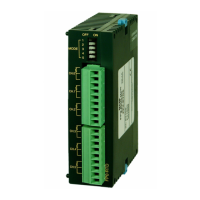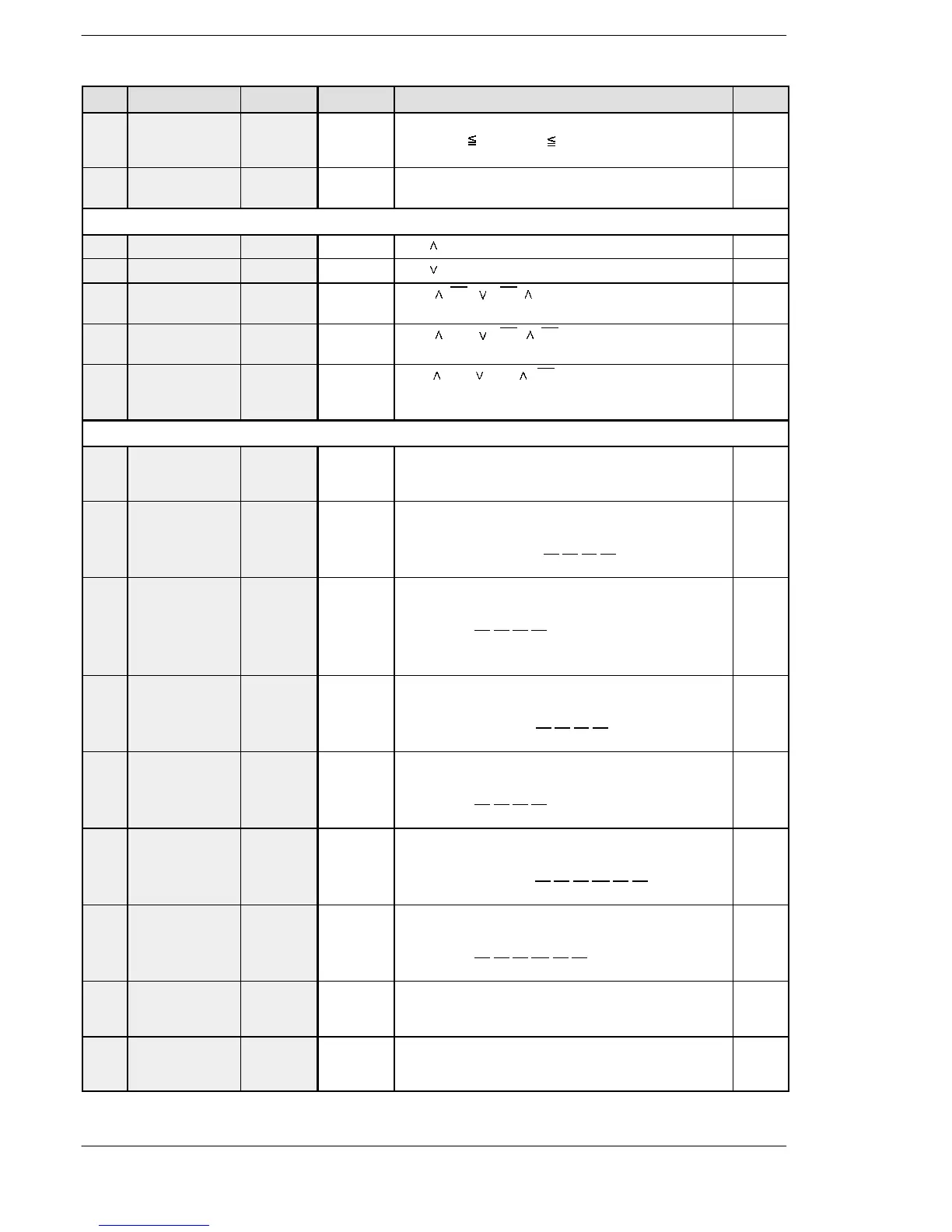FPΣ
Specifications
13 - 54
No. Name Boolean Operand Description Steps
F63 32-bit data
band
comparison
DWIN S1, S2, S3 (S1+1, S1) > (S3+1, S3) → R900A: on
(S2+1, S2) (S1+1, S1) (S3+1, S3) → R900B: on
(S1+1, S1) < (S2+1, S2) → R900C: on
13
F64 Block data
comparison
BCMP S1, S2, S3 Compares the two blocks beginning with “S2” and “S3”
to see if they are equal.
7
Logic operation instructions
F65 16-bit data AND WAN S1, S2, D (S1) (S2) → (D) 7
F66 16-bit data OR WOR S1, S2, D (S1) (S2) → (D) 7
F67 16-bit data
exclusive OR
XOR S1, S2, D {(S1) (S2)} {(S1) (S2)} → (D) 7
F68 16-bit data
exclusive NOR
XNR S1, S2, D {(S1) (S2)} {(S1)(S2)} → (D) 7
F69 Word (16-bit)
data unite
WUNI S1, S2,
S3, D
([S1] [S3]) ([S2] [S3]) → (D)
When (S3) is H0, (S2) → (D)
When (S3) is HFFFF, (S1) → (D)
9
Data conversion instructions
F70 Block
check code
calculation
BCC S1, S2,
S3, D
Creates the code for checking the data specified by
“S2” and “S3” and stores it in “D”.
The calculation method is specified by “S1”.
9
F71 Hexadecimal
data → ASCII
code
HEXA S1, S2, D Converts the hexadecimal data specified by “S1” and
“S2” to ASCII code and stores it in “D”.
Example: HABCD → H42
41 44 43
BADC
7
F72 ASCII code →
Hexadecimal
data
AHEX S1, S2, D Converts the ASCII code specified by “S1” and “S2” to
hexadecimal data and stores it in “D”.
Example: H 44
43 42 41
→ HCDAB
DC BA
7
F73 4-digit BCD
data → ASCII
code
BCDA S1, S2, D Converts the four digits of BCD data specified by “S1”
and “S2” to ASCII code and stores it in “D”.
Example: H1234 → H32
31 34 33
214 3
7
F74 ASCII code →
4-digit BCD
data
ABCD S1, S2, D Converts the ASCII code specified by “S1” and “S2” to
four digits of BCD data and stores it in “D”.
Example: H 34
33 32 31
→ H3412
4321
9
F75 16-bit binary
data → ASCII
code
BINA S1, S2, D Converts the 16 bits of binary data specified by “S1” to
ASCII code and stores it in “D” (area of “S2” bytes).
Example: K-100 → H30
30 31 2D 20 20
001-
7
F76 ASCII code →
16-bit binary
data
ABIN S1, S2, D Converts the ASCII code specified by “S1” and “S2” to
16 bits of binary data and stores it in “D”.
Example: H 30
30 31 2D 20 20
→ K-100
001-
7
F77 32-bit binary
data → ASCII
code
DBIA S1, S2, D Converts the 32 bits of binary data (S1+1, S1) to ASCII
code and stores it in (D+1, D).
11
F78 ASCII code →
32-bit binary
data
DABI S1, S2, D Converts the ASCII code specified by “S1” and “S2” to
32 bits of binary data and stores it in (D+1, D).
11

